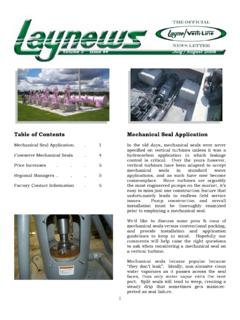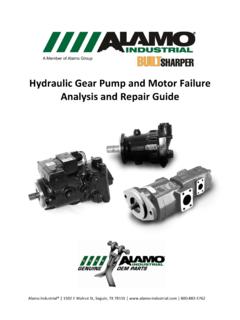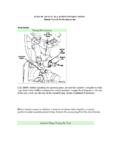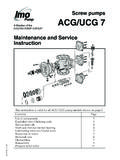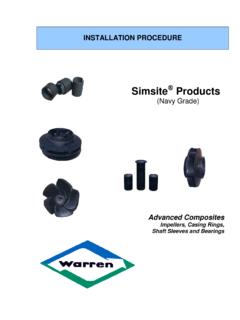Transcription of Edwards Model 150 / 160 / 300 Pump Maintenance …
1 Edwards Model 150 / 160 / 300. Pump Maintenance Manual Contents 3 Installation Safety Inspection .. 3-1. General Precautions .. iii Unpacking .. 3-1. Warnings and Cautions .. iii Repacking .. 3-1. Warnings .. iii Storage .. 3-1. Cautions .. iv Installation.. 3-2. Clean Pump .. 3-2. Mount Pump.. 3-2. 1 General Prepare Foundation .. 3-4. Introduction .. 1-1 Level Pump Skid .. 3-5. Grout Pump Skid .. 3-5. Check Driver Rotation .. 3-6. 2 Maintenance Align Couplings .. 3-7. Piping .. 3-9. Consumable Materials .. 2-1 Strainers .. 3-10. Lubrication .. 2-2 Overpressure Protection .. 3-10. Troubleshooting .. 2-2. Pre-Startup Checks .. 3-11. Removal .. 2-3. Disassembly .. 2-4. General Practice .. 2-4 4 Parts Disassembly Procedure .. 2-4. Cleaning .. 2-6. Inspection .. 2-7 Warranty Repair and Replacement .. 2-7. Assembly .. 2-8. General Practice.
2 2-8. Assembly Procedure .. 2-8. Replacement.. 2-12. i Safety General Precautions The following are general safety precautions not related to any specific procedure. Per- sonnel must understand and apply these precautions during both operation and main- tenance of the pump. Do Not Operate Pump Without Ear Protection. The pump has heat-treated steel timing gears, which can be very noisy when operated above 900 rpm. Be Aware of High Heat When Unit Is Running. Both operating and Maintenance personnel must observe all safety precautions at all times. To avoid injury, always de- energize the input power sources and lock-out or red-tag the controller. Let the pump cool before handling. Be Aware of Chemical Hazards. Maintenance personnel must observe all safety pre- cautions while working with the chemicals used in cleaning agents.
3 Warnings and Cautions The following warnings and cautions relate to specific procedures in this manual. They are repeated here for emphasis. Warnings Do not perform Maintenance using this manual if the Model number on the pump is not 150-348 or the serial number is not _____. Performing Maintenance using the wrong manual could result in pump failure or personal injury. To avoid injury, always de-energize the input driver and lock-out or red-tag the controller. Let the pump cool before removing. Overpressurization of the pump can cause equipment failure, resulting in per- sonal injury. iii Edwards Model 150-348 Pump Do not order parts using this manual if the Model number on the pump is not 150-348 or the serial number is not _____. Using parts ordered from the wrong manual could result in pump failure or personal injury.
4 Cautions Do not hammer on pump endcase. This will cause gasket sealing surface dam- age, resulting in leaks. Use shaft protector between puller tip and shaft face to prevent distortion of shaft center. Never hammer directly on pump drive shaft. This will cause the rotor assem- bly to become misaligned, resulting in incorrect internal clearances. Also, hammering on the shaft ends may damage the shaft centers. Never dip or soak packings, rubber, plastic, or teflon parts in dry cleaning solvent. Wipe with clean, lint-free cloth. Solvent can react with material and result in severe damage or destruction of parts. Do not use excessive force when installing seals. This could damage the seals, causing them to leak. Use approved tools available from Edwards . Do not rotate rotor assemblies until bearings have been installed and adjusted.
5 Damage to rotors and liners may occur. Make sure liners fit into counterbore on endcase, and that they can be fully seated into the endcase counterbore without using excessive force. Damage to endcases and liners could occur. Support ends of shafts axially with a jaw puller on the endcase when install- ing ball bearings to avoid damaging liners and rotors. The jaw puller should be used on the shaft end opposite the end where the bearing is being installed. Use a shaft protector to avoid damaging shaft center. Do not overtighten bearing adjusting nut setscrews. Excessive bearing preload may result, causing bearing damage. Rotary pumps have close running clearances. Thus, clean piping is a must. Dirt, grit, weld bead or scale, flushed from an unclean piping system, will damage and may stall the pump. Flush the system thoroughly before connect- ing piping to pump.
6 Iv General 1. Introduction The Edwards Model 150, Model 160 and Model 300 pumps (Figure 1-1) are standard-duty high-speed gear-driven positive-displacement rotary pumps with gear-type rotors. The pumps are self-priming. Edwards rotary pumps are available in many configurations. While they may look alike, there may be significant differences from one pump to another. Differences include construction material, sealing method, rotor type, etc . Figure 1-1. Edwards Model 150, Model 160 & Model 300 pumps 1-1. Maintenance 2. l Do not perform Maintenance using this manual if the Model number on the pump is not 150-348 or the serial number is not _____. Performing Maintenance using the wrong manual could result in pump failure or personal injury. Edwards rotary pumps are available in many configurations. While they may look alike, there may be significant differences from one pump to another.
7 Differences include con- struction material, sealing method, rotor type, etc. This manual covers only one config- uration, which is defined by a Model number and a serial number. Check the name plate on the pump to make certain the Model number is 150-348 and the serial number is _____. If the numbers do not match, contact Edwards - Pentair Water. Most pump repairs can be performed by Maintenance personnel using normally avail- able tools. Consumable Materials Cleaning materials, lubricants, and other products needed during pump Maintenance are listed in Table 2-1. Table 2-1. Consumable Materials Item Nomenclature Specification Common Name 1 Lint-Free Cloth MIL-C-85043. 2 Dry Cleaning Solvent Acetone, Brake Cleaner 3 Emery Cloth 220 Grit 3M, Anderson, Sandvik, Mirka 4 Anti-Seize Compound Nev'r Seize . 5 Red Loctite PermaLoc HH-120.
8 6 High-Tack Gasket Spray Loctite, Permatex 2-1. Model 150 / 160 / 300 pumps Table 2-1. Consumable Materials (Continued). Item Nomenclature Specification Common Name 7 General Purpose Grease MIL-G-18709 Chevron Ulti-Plex, NLGI #2 Shell Retina LC. 8 Lapping Compound D51804, 180 Grit Felpro Clover . Silicon Carbide Brand Zerk fittings do not Lubrication have check balls. To ensure a long service life, the pump should be lubricated routinely with approved This prevents bear- grease (7, Table 2-1). If the pump is operating under normal loads and temperatures, ings from being use the intervals defined in Table 2-2. If the pump is operating at over 180 F, contact over-greased. Edwards for recommended lubrication interval for your application. Excess grease will run out of the fit- Table 2-2. Lubrication Schedule ting when pump is in operation.
9 Item Interval Amount of Grease Bearings 4,000 Hours Ounce Timing Gears 4,000 Hours Ounce Troubleshooting Table 2-3 provides assistance in diagnosing and correcting malfunctions that may occur during normal operation. Table 2-3. Troubleshooting Trouble Probable Cause Remedial Action 1. Pump does 1a. Seized pump. 1a. Repair or replace pump. not turn 1b. Faulty or misaligned 1b. Replace or realign coupling. coupling. The pump has 1c. Damaged or missing 1c. Replace key. heat-treated steel shaft key. timing gears, 2a. Loose or misaligned 2a. Tighten, align, or replace which can be very 2. Excessive Noise coupling. coupling. noisy when oper- ated above 900 2b. Cavitation. 2b. Check suction piping with rpm. This is a nor- a vacuum gauge. Gauge mal condition, and should read less than 10- does not require in. Hg in most cases.
10 Maintenance Contact E dwards for the action. exact reading for your application. 2-2. Maintenance Table 2-3. Troubleshooting (Continued). Trouble Probable Cause Remedial Action 2c. Worn or damaged 2c. Repair or replace pump. bearing(s). 3. Excessive 3a. Loose or misaligned 3a. Tighten, align, or replace vibration coupling. coupling. 3b. Cavitation. 3b. Check suction piping with a vacuum gauge. Gauge should read less than 10- in. Hg in most cases. Contact Edwards for the exact reading for your application. 3c. Worn or damaged 3c. Repair or replace pump. bearing(s). 4. Reduced flow 4a. Clogged suction screen. 4a. Clean or replace screen. 4b. Cavitation. 4b. Check suction piping with a vacuum gauge. Gauge should read less than 10- in. Hg in m ost cases. Contact Edw ards for the exact reading for your application. 4c. Pump liners and/or 4c.


